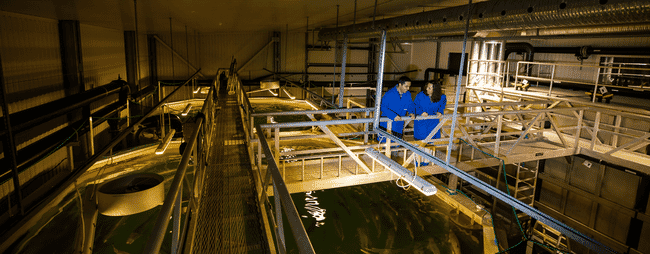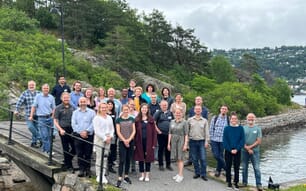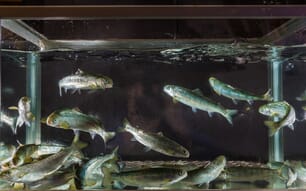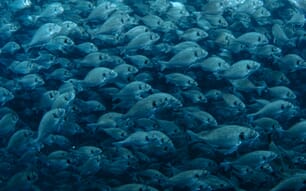
© Nofima
The importance of light for Atlantic salmon
Light is essential to the majority of life on earth. There are three characteristics of light that are important:
I) its intensity or the quantity of illumination, II) its wavelengths or colour and III) its duration or photoperiod. Light in a natural aquatic environment changes daily, seasonally and can vary between different aquatic ecosystems. Fish in their natural environment have adapted their life cycles, behaviour and physiology to account for ever-changing lighting conditions.
Light has a major effect on the life of Atlantic salmon. These effects can impact events that are important for the salmon’s daily life, such as feeding efficiency: Atlantic salmon are visual feeders, meaning that they need a certain level of light to successfully find and capture feed. Light also affects key aspects of the salmon’s life cycle: photoperiod duration is important for spawning, growth and migration in salmonid fish. For example, smoltification, where the salmon transition from freshwater adapted parr into seawater adapted post-smolts is induced by the seasonal changes in daylight.
Light is an important environmental factor that has been used to optimise production of Atlantic salmon. Research and production practices have shown that we can successfully use light manipulation to induce smoltification, improve growth, modulate feeding, influence swimming behaviour and also control sexual maturation, in addition to a number of other factors. However, inappropriate lighting conditions can also lead to reduced smolt quality, and can contribute to issues including vertebral deformities, eye damage, stress and premature sexual maturation.
A new production environment for Atlantic salmon
The rules for production of Atlantic salmon on land in Norway have been changing since the early 2010s. Atlantic salmon smolts have been traditionally produced in land-based tanks up to 100 g, using photoperiod manipulation as the primary driver for smoltification. In 2011 new regulations allowed farmers to produce Atlantic salmon on land up to 1000g, and from 2016 the regulatory framework made it possible for farmers to produce salmon up to slaughter size solely on land. The size of the fish produced on land in Scotland, Chile and Australia also started to increase and a number of projects for grow-out of salmon on land are being planned and/or realised around the world.
Prolonged production on land provides several opportunities and these include reducing the times fish are held in cages during the on-growing phase. Transferring larger fish to sea has allowed farmers to shelter their fish longer from lice and other diseases that can impact upon open net pen marine production, and land-based production offers farmers the opportunity to better regulate conditions for fish welfare and performance. The industry also started looking into alternative ways to smoltify fish using feed, salinity or simply their size.

Recirculating aquaculture systems (RAS) have become the preferred facilities for the land-based production of Atlantic salmon in Norway and worldwide, as they have allowed for increased production using the same amount of water. Numerous large-scale RAS facilities have been built in the last 10-15 years, and the scale of RAS production is increasing all the time. For example, tank sizes are increasing from around 100 m3 to over 2000 m3. The lack of available surface area has also meant that tank depths have increased from 1-2 m to over 5 m. As all RAS facilities are roofed, what has happened to the lighting in such RAS facilities?
Lighting in RAS facilities
Fish are generally subjected to artificial light in RAS facilities and, so far, lighting conditions have not been standardised in closed-containment systems. In recent years, the aquaculture industry has started to move towards the use of light emitting diodes (LEDs), both in Norway and worldwide. LED technology allows the user to control light intensity, wavelength and photoperiod and LEDs are more durable and energy efficient than traditional fluorescent or metal-halide lamps. Furthermore, the use of narrow spectra LED light, specifically blue light LEDs, has already had a documented positive impact on the production of Atlantic salmon post-smolts in sea cages, making LEDs an obvious choice for fish farmers operating RAS.
Lighting in traditional freshwater RAS systems that used more shallow (1-2 m) deep tanks and contained fewer fish per tank was not a considered a problem. However, in the late 2000s the tanks grew in size and depth, the size of and number of fish in them increased and novel ways were developed to produce smolt in RAS. However, the water quality in those systems (often turbid water) made me consider the lighting conditions that the fish were experiencing. How much light were fish getting at 5 m depth? What were the lighting conditions in the tanks? What was the light quality the fish were experiencing? How did a lack of photomanipulation affect smolt quality? How did the lighting conditions affect salmon welfare and growth in large, deep tanks?
Together with my colleagues from Nofima and NORCE we have started looking for answers as a part of the Research Council of Norway’s SFI CtrlAQUA project. I was initially surprised that there was very little concrete information relating to recommended and optimal lighting conditions (quality and quantity) for Atlantic salmon raised in RAS. One could argue that the same recommendations for the Atlantic salmon reared in other systems should apply. However, the state-of-the-art knowledge of lighting conditions for smolt production was mainly given in lux, which did not take into the account all relevant wavelengths for Atlantic salmon and was related to clear water. When it comes to post-smolts, literature referred mainly to the work done in sea cages and/or clear water, where conditions for light penetration and absorption were different from RAS, where water may be turbid.
Our initial measurements showed that, in RAS without disinfection, at 0.5 m depth in the tanks light levels were 90 percent lower than at the tank surface. We also found lighting dead zones at the bottom of some deep tanks.
To determine the effect of different light intensities and light qualities on Atlantic salmon post-smolt we have done an experiment in CtrlAQUA using narrow spectra white LED and full-spectra LED light at two different average intensities, in RAS without disinfection. In this experiment we show that light intensity of 0,25µE does not have negative effects on salmon performance and that the light in the blue part of the spectra is more readily absorbed compared to rest of the spectra. My colleague Andre Meriac will present more results from this study at the forthcoming webinar on Smolt production in the Future, on 21 October.
Future considerations
The salmon farming industry is already working hard to optimise lighting conditions in RAS for the production of smolts and post-smolts. The use of underwater lights in deep tanks and optimisation of LED spectra are already happening. However, the large investments and local effects of these actions will not be able to resolve all lighting issues in RAS. Another important aspect that must be considered is the water colour and particle content in RAS. Some have voiced the opinion that fish might prefer living in murky water, as it could provide shelter and reduce their stress levels. However, so far, we do not have any documentation to sustain such claims. On the other hand, we are starting to see how the presence of particles affects light penetration, quality and quantity.
Atlantic salmon are currently spending more time on land under artificial lighting conditions that are different to the conditions that await them in sea cages. We know very little about how this affects the transition and if there are any long-lasting consequences for fish after they are transferred to marine net pens.
In the end, the lighting conditions in RAS must support all the biological processes that will prepare Atlantic salmon for life in the sea. But we have only just started to unveil precisely what those conditions are.






